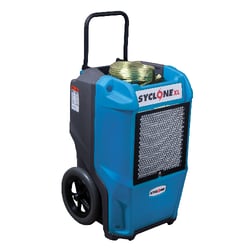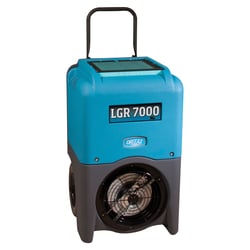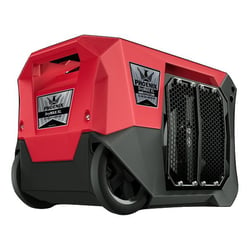Post 1 of 2 in our Dehumidifier Series
It is essential that you have the right dehumidifier because you want to make sure that you respond to water damage in a timely manner so that secondary loss doesn’t occur.
In order to successfully remove water, you will need to have the right dehumidifier for the job.
Keep reading to learn everything that you need to know about how to pick the right dehumidifier so that you will be prepared for whatever this hurricane season throws at you.
Understanding What a Dehumidifier Does
Dehumidifiers are built to remove moisture from the air by using cool coils and other technology that condenses moisture into water.
Conventional dehumidifiers used to be the only option available but with the rapid improvement of technology, there are now many different types of dehumidifiers.
It’s important to understand what each type of dehumidifier does and what its limitations are so that you can pick the correct one for the job:
Low-Grain Refrigerant (LGR) dehumidifiers-
Low-Grain refrigerant dehumidifiers use a double cooling system to remove moisture down to a low-grain setting (Grains per pound is the industry standard used to measure moisture. One grain is one drop of moisture, and there are 7,000 grains of moisture in one pound).
This process is accomplished by running the captured moisture through two sets of exchangers to bring the dew point down and remove more water.
ngineers are continually focused on improving LGRs to get them to perform in the driest conditions possible.
High-Temperature Low Grain (LGR) dehumidifiers- These are the same as your standard LGR dehumidifier, but they are capable of operating at higher temperatures, meaning that you can use them in a wider range of environments.
Desiccant Dehumidifiers- Desiccant dehumidifiers work differently than LGRs. The blower on the unit forces air into it and funnels it through the rotating desiccant wheel. Silica gel will then absorb the moisture.
Part of the air taken into the unit is processed and released back into the environment, and the rest of the moisture is heated and expunged from the gel through a duct.
These dehumidifiers create desert-like drying conditions and are best for cool and dry sites, or for drying dense materials such as hardwood floors.
The 5 Questions That You Need to Ask Yourself Before Buying a Dehumidifier
I sat down with two industry experts who have decades of experience buying, selling, and using dehumidifiers.
These are the 5 most important things that they said to concentrate on when selecting your dehumidifier:
1. In truth, there is no one dehumidifier that is the “perfect fit” for every job. Which dehumidifier is right for your job?
Every flooded home is different.
The temperature of the house will vary, the amount of power that you have to work with will change, and the size of the space that you are working in will vary.
Despite this, you should be able to reference typical conditions that you will be operating in so that you have an idea of what equipment most jobs in the area will require. This will help you to narrow down your selection of equipment.

2. How functional and mobile will the equipment be on its way to, from, and at the job site?
“I would avoid dehumidifiers that are difficult to handle. They need to be able to be mobile, and hopefully, one person can maneuver them to set them up at a job. Are they stackable? Because that’s going to take up less room in your vehicle,” Rachel Adams, a restoration expert advises.
You'll want to ask yourself questions like this before you’re at the job site so that you don’t have to lug heavy equipment up the stairs.
By choosing equipment that is easier to maneuver you will make life easier on yourself and your technicians and save time when you are out in the field.
3. Do you have the proper equipment to use with your dehumidifier?
Dehumidifiers are built to remove moisture from the air. They are not evaporation machines.
When the air is hot and wet you will draw more moisture from the surrounding environment.
You want to use other equipment like an E-TES or an air mover to increase evaporation in the room that you are working in. These technologies can be used to manipulate the environment and create optimal operating conditions for the dehumidifier so that it can take water out of the air.
4. What are the Operating Conditions you will encounter in the field?
Performance in Drier Conditions-
The AHAM (Association of Home Appliance Manufacturers) rating of your dehumidifier doesn’t always translate to a real-world job.
These ratings only tell half of the story of what your machine is capable of because AHAM ratings are the manufacturer’s measurement of how many pints of water are removed when operating at conditions of 80 degrees Fahrenheit and 60 percent humidity.
Real-life conditions are never as straightforward as the AHAM test conditions because temperatures and operating conditions on the job will change once you get past the first day of drying and have removed the water that is easy to extract.
Knowing this, you will want to have a product that also performs well in drier conditions (when the air consists of fewer grains of water per pound).
To ensure this, talk to your manufacturer.
They can let you know if your dehumidifier will still be able to work at the lower ranges.
You can also ask them to give you the AHAM ratings at drier conditions before choosing to buy the unit.
Amperage
A lot of manufacturers try to make the Amperage as low as possible and that’s for two reasons:
- They are trying to get as much water removal per amp as they can
- They are also trying to make it so that you can use more dehumidifiers on the job.
You want to be able to use as many units as you can but also make sure that the circuit can handle everything that’s plugged in. Putting more equipment on a circuit is ideal because electricity is at a premium.
When choosing a dehumidifier ask yourself: how many pints of water removal am I able to achieve per AMP?
5. Have I standardized my equipment?
Today’s manufacturers offer so many different products. With so many choices you need to be careful that you are choosing correctly.
If you are on the job and need technical help it’s better for you to stick to the same make and model of equipment.
“I like to stick with one manufacturer, that way I’m doing the volume of my work with them. That way if I have a problem I can always call them and say: hey this is what happened,” explained another restoration expert.
“My point is getting to know someone there--either a vendor or distributor that I can call all the time and say ‘I have this question that needs to be answered,’ and then also having the same pieces of equipment.”
Choosing the same SKU also makes your life much easier at the job site because you will have a lot fewer moving pieces to address.
“I wouldn’t mix them up for a few reasons. One is for when I call into technical support to talk about how they are working, but also it helps with training with my technicians as well,” they explain.
“If you’re using the same unit, whether it’s at Ms. Jones or Ms. Smith’s, and you don’t have to stop and think and recalculate that this is Machine A and this is Machine B, then this makes training and support easier.”
Don’t forget that you will also need to replace the filters inside of your dehumidifiers and maintain them on a regular basis. It is not uncommon for dehumidifiers to require different parts. By selecting the same ones you won’t have to worry about keeping an excessive number of replacement filters and maintenance parts in your inventory.
“Find a unit that works well for you, a manufacturer, a model that you like, and make the bulk of your products that unit,” the experts explain.
Conclusion
Every contractor knows that getting the most bang for their buck is a juggling act.
While the major dehumidifier brands have more in common than they differ, incremental improvements are always being made as engineers push their machines to outperform the competition.
As a prudent business owner, you want to run a good budget. One of the best ways to do this is by choosing a dehumidifier that is the most versatile. The best solution for your business is to choose a unit that balances cost, total pints removed, and the number of pints removed per AMP.
A good strategy is to have 80 percent of your machines in the XL category such as the Phoenix Dry Max XL so that you can pull out the most water, and have the remaining 20 percent be large dehumidifiers so that you can spread out between other job sites.
Another way of looking at this recommendation is that if the size isn’t an issue your XL Dehumidifiers can be used as your workhorse dehumidifiers with the intention to maximize drying (using a large unit will enable you to finish the job more quickly).
For small jobs or for ones that you need a little extra removal, you can use your remaining large dehumidifiers.
Just like any other equipment, you will get the most lifetime use from your dehumidifier as long as you take care of it. Make sure to always perform proper maintenance, clean the coils and change the filters on a regular basis.
Enjoyed reading this post? Read the following articles:

Featured Products

Syclone, Dehumidifier with Filter, XL LGR, Blue

Dri-Eaz, Dehumidifier, LGR 7000 XLi





